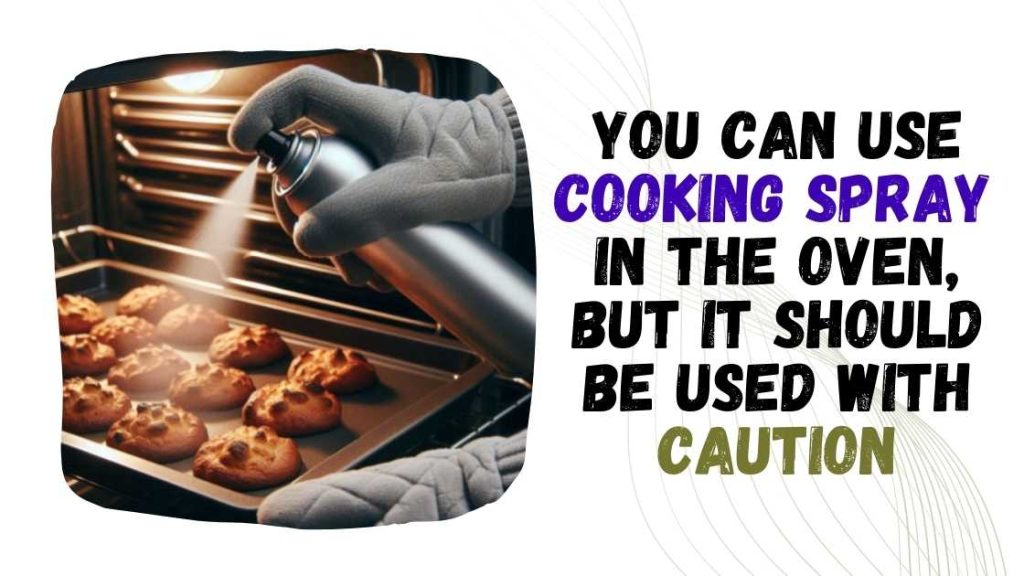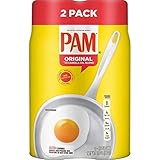Yes, you can use cooking spray in the oven, but it should be used with caution. Cooking spray is a convenient tool for preventing food from sticking to cookware or baking dishes. However, its effectiveness and safety depend on how and where it’s applied.
| Aspect | Data/Information |
|---|---|
| Maximum Safe Temperature | 400°F (204°C) for most cooking sprays |
| Common Ingredients | Oil, lecithin, propellants (butane, propane) |
| Risk of Sticky Residue | Increases when used at temperatures above 400°F |
| Impact on Cleaning | May require more frequent and thorough cleaning of oven surfaces |
| Frequency of Use in Home Baking | 78% of home bakers report using cooking spray for non-stick purposes |
| Recommended Use | Light, even application on cool surfaces; avoid direct contact with oven walls or racks |

Cooking spray is primarily made of oil, lecithin, and propellants like butane or propane. Spraying it on a cold surface before baking helps to prevent sticking and makes it easier to remove baked goods or roasted foods. The key is to apply it properly—usually on baking sheets, muffin tins, or directly on the food itself.
However, the propellants in cooking sprays can become problematic at high temperatures. Most sprays are safe to use up to about 400°F (204°C), beyond which the propellants can degrade, potentially creating a sticky residue or even causing the spray to smoke. This not only affects the quality of your food but may also make cleaning your cookware more difficult.
Another factor to consider is the impact on your oven’s interior. Using cooking spray regularly can cause a buildup on oven racks and walls, making cleaning more difficult.
Basics of Cooking Spray
Cooking spray is a handy tool in the kitchen. It is commonly used to evenly coat cookware and food surfaces with a thin layer of oil. Here’s a basic rundown:
How to Use Cooking Spray
- Pans and Bakeware: Cooking spray is often used to lightly coat the surface of pans or bakeware, helping to prevent food from sticking during cooking or baking. It’s especially handy for low-fat cooking as it adds minimal oil.
- Directly on Food: You can spray directly onto foods like vegetables or meats before roasting or grilling. This ensures an even coating without the need for brushing or drizzling.
Benefits
- Even Coating: Cooking spray provides a more uniform layer of oil, which can be difficult to achieve with pouring or brushing.
- Calorie Control: It’s a great option for those looking to reduce fat and calorie intake since it uses less oil.
- Convenience: Quick and easy to apply, especially for baking and grilling.
Precautions
- Overheating: Avoid spraying cooking spray onto a hot pan directly, as the propellant can cause the spray to ignite.
- Build-Up: Cooking spray can sometimes leave a residue on non-stick cookware if used excessively, so occasional cleaning with baking soda or a gentle scrubber may be necessary.
- Ventilation: Use cooking spray in a well-ventilated area, as the aerosol can sometimes be irritating if inhaled.
Alternatives
- Misting Bottles: For more control and to avoid the chemicals in aerosol sprays, consider using a reusable oil mister filled with your favorite cooking oil.
- Brushing or Wiping: You can also use a pastry brush or paper towel to spread a thin layer of oil, which serves the same purpose without the aerosol.
Using Cooking Spray in the Oven
Using cooking spray in the oven is a common practice, especially for baking and roasting. Here’s how to use it effectively and safely:
When to Use Cooking Spray in the Oven
- Baking: Coat cake pans, muffin tins, and cookie sheets with cooking spray to prevent baked goods from sticking. It’s especially useful for items like cakes, brownies, and quick breads.
- Roasting: Lightly spray roasting pans or baking sheets before roasting vegetables, meats, or fish. This helps prevent sticking and promotes even browning.
- Baked Goods: Use it to grease loaf pans, pie plates, or tart pans to ensure easy release of baked goods.
How to Use Cooking Spray in the Oven
- Before Preheating: It’s best to spray your pans or bakeware before placing them in the oven. Spray over a sink or trash can to avoid overspray on countertops or floors.
- Even Coating: Hold the can about 6-10 inches away from the surface and spray in a sweeping motion for an even coating.
- Non-Stick Cookware: If using non-stick cookware, a light spray is usually sufficient. Be mindful not to over-spray, as this can create a sticky residue.
Tips for Safety and Effectiveness
- Avoid Hot Surfaces: Never spray cooking spray onto a hot pan or dish, as this can cause the oil to ignite or splatter. Always spray when the cookware is cool.
- Prevent Over-Spraying: To avoid excess spray, which can cause build-up or smoke, apply a thin, even layer. A little goes a long way.
- Ventilation: Ensure proper ventilation when using cooking spray in the oven. If you notice smoking, it could be due to excess spray or high temperatures. Reduce the temperature slightly or apply less spray next time.
Cleaning Up
- Residue: If you notice a build-up of cooking spray residue on your bakeware or oven, clean it with a mixture of baking soda and water or a gentle scrubbing pad.
- Oven Maintenance: Periodically clean your oven to remove any accumulated residue from cooking sprays, which can sometimes cause smoking during preheating.
Best Practices
- Stick to Lower Temperatures: Cooking sprays work best at moderate oven temperatures. If you’re baking at high heat (above 400°F/200°C), consider using parchment paper or a silicone baking mat in addition to a light spray.
- Check Labels: Some cooking sprays are better suited for high-heat cooking. Look for ones labeled as “high-heat” or “oven-safe” if you frequently roast or bake at high temperatures.
Alternatives to Cooking Spray
You’re absolutely right! These alternatives to cooking spray are effective, versatile, and often add a bit more flavor or texture to your dishes. Here’s a bit more on each:
1. Butter or Margarine
- Flavor Boost: Butter adds a rich flavor that cooking spray doesn’t provide. Margarine is a good substitute if you’re avoiding dairy.
- Application: Use a pastry brush, paper towel, or even your fingers to apply a thin, even layer. This method works well for baking cakes, cookies, and savory dishes.
- Best For: Baking, sautéing, and adding a golden brown finish to the top of baked goods.
2. Vegetable Oil
- Versatile: Vegetable oil is a great all-purpose option. It’s neutral in flavor and has a high smoke point, making it suitable for a variety of dishes.
- Application: Brush or drizzle the oil onto pans or directly onto foods. A heat-resistant silicone brush works best for even application.
- Best For: Roasting vegetables, baking, and grilling.
3. Parchment Paper
- Non-Stick Surface: Parchment paper is a fantastic non-stick surface that eliminates the need for oils or sprays. It’s also great for easy clean-up.
- Usage: Line baking sheets, cake pans, or roasting pans with parchment paper. It’s perfect for cookies, pastries, and even roasting vegetables or meats.
- Best For: Baking, roasting, and candy-making (as it withstands high temperatures without sticking).
Additional Alternatives:
- Silicone Baking Mats: Reusable and durable, silicone mats offer a non-stick surface similar to parchment paper. They’re perfect for baking cookies, roasting, and more.
- Olive Oil: For a richer flavor, olive oil can be used in place of vegetable oil. It works well in roasting and baking, though it has a lower smoke point.
- Flour Dusting: For baking, particularly with cakes, dusting the pan with flour after greasing with butter or oil can help ensure an even release.
- Coconut Oil: A great option for baking, especially in recipes where a subtle coconut flavor is desired. It has a high smoke point and solidifies at room temperature.
What Temperature is Safe for Cooking Spray in the Oven?
Cooking sprays are generally safe to use at typical baking temperatures, which range from 350°F to 400°F (175°C to 200°C). However, if your recipe requires higher temperatures, it’s essential to check the label on your cooking spray. Some sprays have a lower smoke point and may break down or burn at higher temperatures, which could affect the flavor of your food or create smoke in the oven.
Does Cooking Spray Leave a Residue in the Oven?
Cooking spray can leave a residue on your pans, bakeware, and even inside your oven. This residue is more likely to build up if you use too much spray or if you use it frequently. Over time, this buildup can become sticky or create a brownish film. To avoid this, use the spray sparingly and consider cleaning your oven and bakeware regularly to remove any residue.
Is Cooking Spray Better Than Oil in the Oven?
Cooking spray and oil each have their benefits in the oven. Cooking spray offers a quick and easy way to coat a baking dish or pan with a thin layer of oil, which helps prevent sticking. It’s also convenient and less messy. However, oil may be preferable in recipes that require more flavor or when you need to cover a larger area more evenly. Additionally, some oils, like olive oil, have a higher smoke point than some cooking sprays, making them better suited for high-temperature cooking.
Can Cooking Spray Affect the Taste of Baked Goods?
Cooking spray is usually flavorless, so it shouldn’t significantly affect the taste of your baked goods. However, some sprays contain additives like lecithin, which can leave a slightly off taste if used in excess. If you’re baking something delicate, like a cake or pastry, you might want to use a neutral-flavored oil or butter instead to ensure that the flavor of your food shines through without interference.
How Can I Avoid Smoke When Using Cooking Spray in the Oven?
To avoid smoke when using cooking spray in the oven, make sure to use a spray with a high smoke point, such as those made with canola or vegetable oil. Avoid using too much spray, as excess can drip and burn on the bottom of the oven. Also, be sure not to spray directly onto the oven’s heating elements. If you notice smoke during baking, reduce the oven temperature slightly and ventilate the kitchen by opening a window or turning on an exhaust fan.
Is It Safe to Use Cooking Spray on Non-Stick Bakeware?
Yes, you can use cooking spray on non-stick bakeware, but it’s not always necessary. Non-stick surfaces are designed to prevent food from sticking, so you may not need additional spray. However, if you choose to use it, apply a light coat to avoid buildup. Over time, the lecithin in cooking spray can leave a sticky residue on non-stick surfaces, potentially reducing their effectiveness. To maintain your bakeware’s non-stick properties, consider using butter or oil, or simply rely on the non-stick coating itself.
Final Decision
When it comes to using cooking spray in the oven, it is best to avoid it to prevent potential fire hazards and messy residue. Instead, opt for alternative options like butter, vegetable oil, or parchment paper to achieve the desired non-stick effect.
Remember, safety should always be a priority in the kitchen, and being aware of the proper techniques and tools will ensure a successful cooking experience.

I may be a little “crazy” when it comes to cooking, but I enjoy every minute of it. Spending time in the kitchen itself, whether with my family or my friends, brings me both happiness and exhilaration. This blog was created to showcase my cooking/eating with family and friends. And also as an opportunity to discuss ideas on food and the culinary circle in general.



